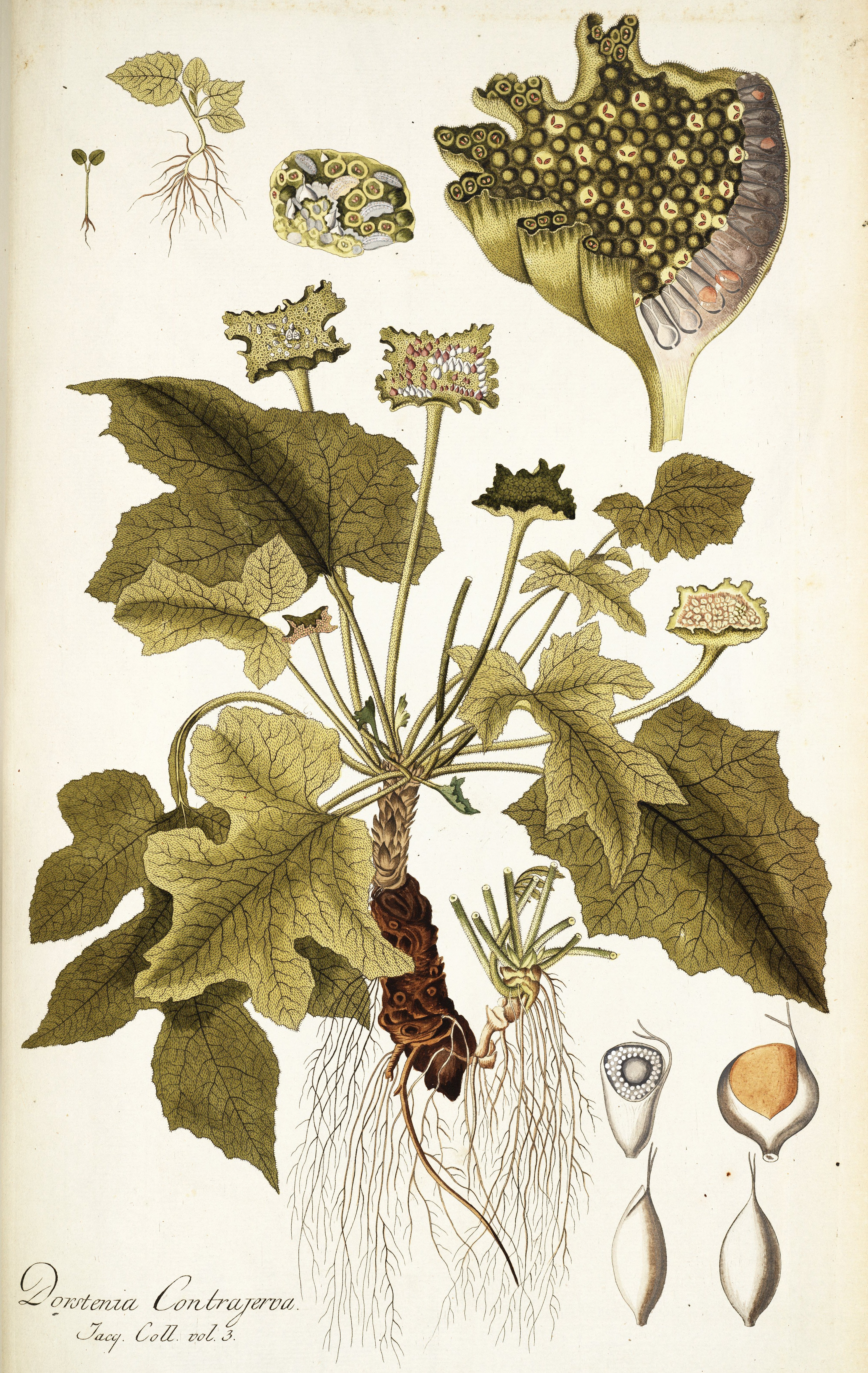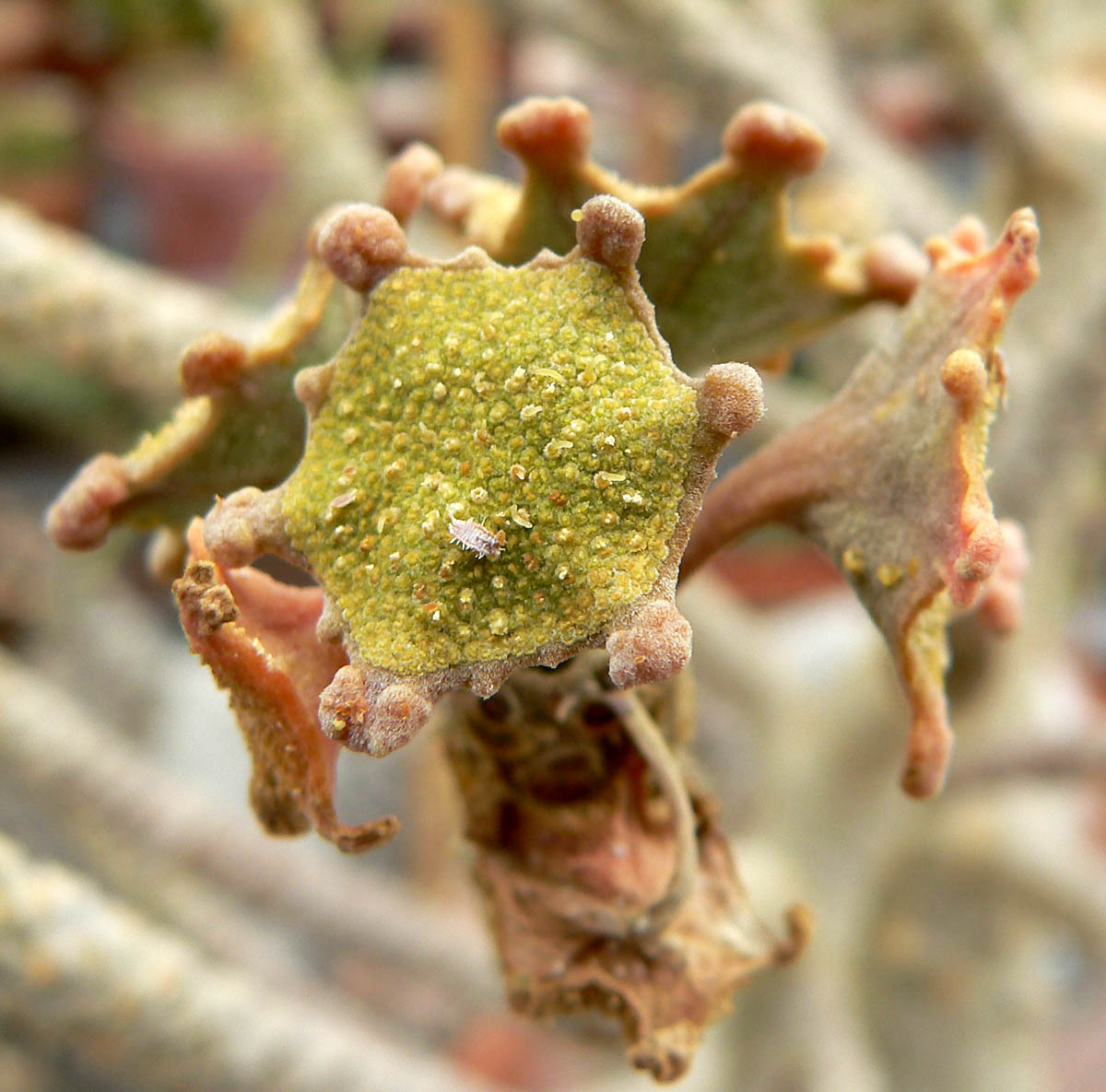|
Dorstenia Contrajerva
''Dorstenia contrajerva'' is a plant species in the family Moraceae. It is native to Northern South America and Central America, and is cultivated elsewhere. The species name "contrajerva" is the Latinized form of the plant's Spanish name, "contrahierba," a name for plants used for treating poisoning and venomous bites and stings, and for which its rootstocks are used in folk medicine (as contrayerva). It is the type species of the Dorstenia genus and was first described by Carl Linnaeus in 1753. Description ''Dorstenia contrajerva'' is a small evergreen perennial plant with a creeping rhizome from which emerges a rosette of leaves with long petioles. Leaves are variably shaped, with plants with lobed and unlobed leaves co-occurring in the same populations. Leaves are up to 20 cm long on petioles up to 25 cm long. When damaged the plant exudes a white latex. Tiny male and female flowers are distributed intermixed on a discoid receptacle of convoluted shape. The frui ... [...More Info...] [...Related Items...] OR: [Wikipedia] [Google] [Baidu] |
Contrayerva
Contrayerva, or contrajerva, is the medicinal rhizome of various tropical Central American and South American species of ''Dorstenia'' in the family Moraceae, mainly '' Dorstenia contrajerva'' and the closely related '' Dorstenia drakena'' but also '' Dorstenia brasiliensis''. The word ''contrayerva'' means “counter herb” in Spanish. It was given this name since a 16th-century description (see below) claimed that the leaves of a herb (''yerva'' = ''hierba'') were used by South American Indians to counter the deadly poisonous effect of the same herb (“contra yerva”) when used as an arrow poison. Seventeenth century herbalists and botanists identified this herb as the aromatic root that had been brought from Peru to England by Francis Drake, and claimed that it was an antidote against all kinds of poison. By the late 18th century contrayerva had lost its reputation as an antidote, but it continued to be listed in European and American pharmacopoeias and herbals until the 1920 ... [...More Info...] [...Related Items...] OR: [Wikipedia] [Google] [Baidu] |
Carl Linnaeus
Carl Linnaeus (; 23 May 1707 – 10 January 1778), also known after his ennoblement in 1761 as Carl von Linné Blunt (2004), p. 171. (), was a Swedish botanist, zoologist, taxonomist, and physician who formalised binomial nomenclature, the modern system of naming organisms. He is known as the "father of modern taxonomy". Many of his writings were in Latin; his name is rendered in Latin as and, after his 1761 ennoblement, as . Linnaeus was born in Råshult, the countryside of Småland, in southern Sweden. He received most of his higher education at Uppsala University and began giving lectures in botany there in 1730. He lived abroad between 1735 and 1738, where he studied and also published the first edition of his ' in the Netherlands. He then returned to Sweden where he became professor of medicine and botany at Uppsala. In the 1740s, he was sent on several journeys through Sweden to find and classify plants and animals. In the 1750s and 1760s, he continued to coll ... [...More Info...] [...Related Items...] OR: [Wikipedia] [Google] [Baidu] |
Dorstenia Contrajerva Leaves Flower
''Dorstenia'' is a genus within the mulberry family, Moraceae. Depending on the author, there are said to be 100 to 170 species within this genus, second only in number to the genus ''Ficus'' within Moraceae. ''Dorstenia'' species are mainly known for their unusual inflorescences and growth habits. ''Dorstenia'' is named in honor of the German physician and botanist Theodor Dorsten (1492–1552).Genaust, Helmut (1976). ''Etymologisches Wörterbuch der botanischen Pflanzennamen'' The type species is ''Dorstenia contrajerva''. Growth habit ''Dorstenia'' is unique in the family Moraceae because of the extremely diverse growth habits and forms of its species. While the majority of Moraceae are woody perennials, ''Dorstenia'' species are predominantly herbaceous, succulent, or suffrutescent perennials. Only 10% exhibit the typical woody habit of the Moraceae. The spectrum of the genus ''Dorstenia'' ranges from small annuals to perennial herbaceous plants with and without rhizomes ... [...More Info...] [...Related Items...] OR: [Wikipedia] [Google] [Baidu] |
Resin
In polymer chemistry and materials science, resin is a solid or highly viscous substance of plant or synthetic origin that is typically convertible into polymers. Resins are usually mixtures of organic compounds. This article focuses on naturally occurring resins. Plants secrete resins for their protective benefits in response to injury. The resin protects the plant from insects and pathogens. Resins confound a wide range of herbivores, insects, and pathogens, while the volatile phenolic compounds may attract benefactors such as parasitoids or predators of the herbivores that attack the plant. Composition Most plant resins are composed of terpenes. Specific components are alpha-pinene, beta-pinene, delta-3 carene, and sabinene, the monocyclic terpenes limonene and terpinolene, and smaller amounts of the tricyclic sesquiterpenes, longifolene, caryophyllene, and delta-cadinene. Some resins also contain a high proportion of resin acids. Rosins on the other hand ... [...More Info...] [...Related Items...] OR: [Wikipedia] [Google] [Baidu] |
Peptide
Peptides (, ) are short chains of amino acids linked by peptide bonds. Long chains of amino acids are called proteins. Chains of fewer than twenty amino acids are called oligopeptides, and include dipeptides, tripeptides, and tetrapeptides. A polypeptide is a longer, continuous, unbranched peptide chain. Hence, peptides fall under the broad chemical classes of biological polymers and oligomers, alongside nucleic acids, oligosaccharides, polysaccharides, and others. A polypeptide that contains more than approximately 50 amino acids is known as a protein. Proteins consist of one or more polypeptides arranged in a biologically functional way, often bound to ligands such as coenzymes and cofactors, or to another protein or other macromolecule such as DNA or RNA, or to complex macromolecular assemblies. Amino acids that have been incorporated into peptides are termed residues. A water molecule is released during formation of each amide bond.. All peptides except cyclic ... [...More Info...] [...Related Items...] OR: [Wikipedia] [Google] [Baidu] |
Vicente Cervantes
Vicente (Vincente) de Cervantes (Ledrada, Salamanca España; 1755 - México; 1829) was a notable Spanish and Mexican physician and botanist. Background Don Vicente Cervantes was a contemporary of Martín Sessé y Lacasta and corresponded with Jean-Louis Berlandier, the French naturalist who botanized in Mexico and Texas as part of the Mexican Boundary Commission. He was also the first Professor of Botany in New Spain, at the Royal Botanic Garden in Mexico City. It is after him that the magnificent Odontoglossum orchid, the "Cervantes Odontoglot" (''Odontoglossum cervantesii''), is named. Juan Diego del Castillo (d. 1793) joined Cervantes in Mexico. Del Castillo left a large sum of money towards the printing of their projected book ''Flora Mexicana''. Cervantes named the genus ''Castilla'', consisting of three large latex yielding trees, after him.M.J.R. Loadman, ''Tears of the Tree: The Story of Rubber –a Modern Marvel'' (Oxford: Oxford University Press, 2005), 25. Notes ... [...More Info...] [...Related Items...] OR: [Wikipedia] [Google] [Baidu] |
Alexiterial
An antidote is a substance that can counteract a form of poisoning. The term ultimately derives from the Greek term φάρμακον ἀντίδοτον ''(pharmakon) antidoton'', "(medicine) given as a remedy". Antidotes for anticoagulants are sometimes referred to as reversal agents. The antidotes for some particular toxins are manufactured by injecting the toxin into an animal in small doses and extracting the resulting antibodies from the host animals' blood. This results in an antivenom that can be used to counteract venom produced by certain species of snakes, spiders, and other venomous animals. Some animal venoms, especially those produced by arthropods (such as certain spiders, scorpions, and bees) are only potentially lethal when they provoke allergic reactions and induce anaphylactic shock; as such, there is no "antidote" for these venoms; however anaphylactic shock can be treated (e.g. with epinephrine). Some other toxins have no known antidote. For example, the pois ... [...More Info...] [...Related Items...] OR: [Wikipedia] [Google] [Baidu] |
Cyclopædia, Or An Universal Dictionary Of Arts And Sciences
''Cyclopædia: or, An Universal Dictionary of Arts and Sciences'' is an encyclopedia prepared by Ephraim Chambers and first published in 1728; six more editions appeared between 1728 and 1751 with a ''Supplement'' in 1753. The ''Cyclopædia'' was one of the first general encyclopedias to be produced in English. The title-page of the first edition summarizes the aims of the author: Noteworthy features The first edition included numerous cross-references meant to connect articles scattered by the use of alphabetical order, a dedication to the king, George II, and a philosophical preface at the beginning of Volume 1. Among other things, the preface gives an analysis of forty-seven divisions of knowledge, with classed lists of the articles belonging to each, intended to serve as a table of contents and also as a directory indicating the order in which the articles should be read. Printing history A second edition appeared in 1738 in two volumes in folio, with 2,466 pages. Th ... [...More Info...] [...Related Items...] OR: [Wikipedia] [Google] [Baidu] |
Polypodium
''Polypodium'' is a genus of ferns in the family Polypodiaceae, subfamily Polypodioideae, according to the Pteridophyte Phylogeny Group classification of 2016 (PPG I). The genus is widely distributed throughout the world, with the highest species diversity in the tropics. The name is derived from Ancient Greek ''poly'' (πολύ) "many" + ''podion'' (πόδιον) "little foot", on account of the foot-like appearance of the rhizome and its branches. They are commonly called polypodies or rockcap ferns, but for many species unique vernacular names exist. They are terrestrial or epiphytic ferns, with a creeping, densely hairy or scaly rhizome bearing fronds at intervals along its length. The species differ in size and general appearance and in the character of the fronds, which are evergreen, persisting for 1–2 years, pinnate or pinnatifid (rarely simple entire), and from 10–80 cm or more long. The sori or groups of spore-cases (sporangia) are borne on the back o ... [...More Info...] [...Related Items...] OR: [Wikipedia] [Google] [Baidu] |




.jpg)
